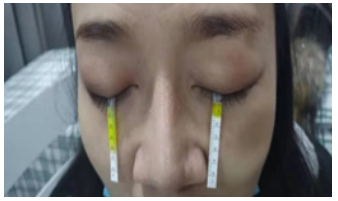Case Report - (2022) Volume 7, Issue 1
The walnut shell moxibustion may be a potentially effective treatment for video display terminal visual fatigue
2The Center for Prevention and Treatment of Hospital of Chengdu University of Traditional Chinese Med, China
3Director of the Center for Prevention and Treatment of Hospital of Chengdu University of Traditional, China
Received Date: Dec 17, 2021 / Accepted Date: Dec 23, 2021 / Published Date: Jan 03, 2022
Copyright: Copyright: ©2022: Gong Ru, et al. This is an open-access article distributed under the terms of the Creative Commons Attribution License, which permits unrestricted use, distribution, and reproduction in any medium, provided the original author and source are credited.
Citation: Gong Rui, Ren Yuan-fang, Lan Ying, Ma Ting-ting and WU Jie (2022) The walnut shell moxibustion may be a potentially effective treatment for video display terminal visual fatigue. Journal of Clinical Review & Case Reports 7(1): 794-796.
Abstract
Background: Video display terminals (VDT) visual fatigue is a common disease in ophthalmology. Its incidence has been increasing in recent years because of the proliferation of mobile devices. There are no recognized and effective treatment options of VDT visual fatigue, so it’s necessary to explore any other effective method.
Objective: To discuss a 39-year-old patient with VDT visual fatigue for more than two and a half year, with a purpose to introduce a potentially effective treatment for VDT visual fatigue.
Conclusion: For other patients of VDT visual fatigue, bottles of eye drops are necessities to get an immediate relief. For the patient we treat, the walnut shell moxibustion can provide both immediate and persistent effect. Therefore, it may be a worthwhile option to try.
Keywords
Video Display Terminal Visual Fatigue, VDT, Visual Fatigue, Walnut Shell Moxibustion, Mmoxibustion
Introduction
Video display terminal (VDT) visual fatigue is a series of visual symptoms caused by prolonged close contact with video display terminals [1]. VDT visual fatigue has a variety of ocular symptoms such as dry eyes, photophobia, tearing, tingling, sore and puffy eyes, diplopia, frequent blinking, heavy eyelids, blurred vision and so on. VDT visual fatigue can seriously affect the life quality of patients. It can even cause musculoskeletal and neuropsychiatric symptoms [1]. VDT visual fatigue may occur at any age, but the onset age was gradually younger. Specific tests for VDT visual fatigue are still vacancy. The diagnostic criteria are primarily based on symptoms of VDT visual fatigue.
The pathogenesis and related factors of VDT visual fatigue are complex. So there are few effective treatments including lactobacillus KW3110 [2], bilberry extract [3], dietary taurine supplementation [4], polyphenol [5], maquiBright® [6], sesamin cupping7 and acupoints massage [8]. All treatment options are still being explored, and none of them can ensure to work 100%. Therefore, treatment of VDT visual fatigue remains a therapeutic dilemma.
The walnut shell moxibustion is a kind of moxibustions, which is a treatment that originated in China. The appearance of walnut shell moxibustion just likes a special pair of glasses. The walnut shells oust the eyeglasses and two small iron cages are linked on the frame like figure 1. Walnut shell moxibustion can promote the absorption of traditional Chinese medicine through the warm effect of moxibustion.

Figure 1: The specially made spectacle frame with two walnutshells (outside).
Method
Patient
The patient was a 39-year-old woman, whose daily average length of time with the eyes was over 6 hours. The patient described after she stayed up late, the responses may include tearing of the eyes, dry eyes, ocular pain, frequent blinks. These symptoms lasted more than two and a half years. In her recent subjective refraction, the uncorrected visual acuity (UCVA) was OS 0.25 diopters (D) and OD 0.3 diopters (D), while the best spectacle-corrected visual acuity was OS 0.8 diopters (D) and OD 0.9 diopters (D). She did not do any other examinations and use any drug for the eye symptoms. Until the Aug 31, 2020, the patient felt that everything got much worse. Besides the persistent symptoms, there was a gradual onset of itching, redness, burning and heaviness of eyes, having a foreign body in eyes, blurred vision, diplopia, photophobia, and decreased vision. Therefore, she came for seeking medical help.
Before the patient was treated, we’ve done basic tests. The Schirmer’s test (5mm*35mm filter paper strips provided by Liaoning Mei Zhi Lin pharmaceutical co., Ltd. China) shows that her left eye result was more than 35 mm, while the right eye result was 30 mm like figure 2. The amplitude of accommodation was OD 0.0667, OS 0.0625 and OU 0.0625. The accommodative facility was OD 7 cpm fail (-) and OS 10 cpm fail (-).

Figure 2: The Schirmer’s test before treatment.
In addition to objective indicators, we also used subjective scales to assess the patient’s ocular conditions. The computer vision syndrome questionnaire (CVS-Q) was developed with wide consensus among experts and was well accepted by the target group. The patient’s CVS-Q score was 33. The score on the national eye institute visual functioning questionnaire-25 (NEI VFQ-25) was 53.
Treatment
First, soak two walnut-shells, which have two or three small holes, in decocted Chinese medicinal herbs (Qiju DiHuang Decoction) for more than 1 hour. Install the two walnut-shells on a specially made spectacle frame (Yi Kang Ai moxa products co., Ltd. China). Hold two moxa sticks (with a length of 2-3cm) on the specially made spectacle frame, then burn. Help the patient wear the customized spectacle frame and wait for the moxa sticks burning off. It will take around 30-40 minutes. The patient will receive the same treatments for 4 weeks and 3 times every week.
Results
Visit 1: Sep 3, 2020. After the patient received the first treatment, most symptoms, especially dry and pain of the eyes, had been alleviated and this effect lasted for 2 days.
Visit 2: Sep 28, 2020. All the treatments had been finished and she declared that only three kinds of symptoms left behind, which were itching, redness and burning of the eyes. At the same time, the frequency of itching dropped from very often to once in a while. Eye examinations showed that her accommodative facility had been improved obviously. The result was OD 13 cpm fail (-) and OS 13 cpm fail (-). However the results of the Schirmer’s test and the amplitude of accommodation didn’t change significantly. The CVS-Q score dropped to 3, which was 33 before treatments. And the score on NEI VFQ-25 dropped to 10.
Visit 3: Oct 9, 2020. After the treatments, the patient claimed that the effect had lasted until the last visit. The CVS-Q score was 4. And the score on NEI VFQ-25 was 8.
All the results of ophthalmologic examine were showed in Table 1.
Table 1: The ophthalmologic examine findings of the patient.

Discussion
In recent years, with the popularity of smartphones, the incidence of VDT visual fatigue has increased significantly [9].When working or studying with VDT, staring at the display screen for long time will reduce the number of eye blink, which is not conducive to the secretion of the eyelid gland and will increase the evaporation of tears. Gradually, the visual fatigue caused by VDT occurred [10].Compared with normal people, patients with VDT visual fatigue always have lower amplitude of accommodation and accommodative facility [11].
The walnut shell moxibustion is a kind of sandwiched moxibustion. It was first recorded in Yangyi Daquan born in the Qing dynasty. The walnut shell moxibustion can be used to treat skin and external diseases in ancient time, and is applied in the field of ophthalmology. The eyes are fragile. The shape of walnut shells is similar to our eyes. They can mitigate the thermal stimulation of moxibustion when they are placed in front of the patient‘s’ eyes. The walnut shells were the carrier of traditional Chinese medicine liquid. The liquid would slowly and persistently fumigate on the eyes with the warming effect of moxa sticks. At present, the walnut shell moxibustion with traditional Chinese medicine decoction is used to treat senile cataract, visual fatigue, xerophthalmia, myopia, exposed conjunctivitis, paralytic strabismus, etc.
As the above, patients with VDT visual fatigue always have lower amplitude of accommodation and accommodative facility. In the case, we get a significant improvement in the accommodative facility. The scores of CVS-Q and NEI VFQ-25 reflected the subjective feelings of the patient. Both have significant drop, which means the patient’s symptoms were effectively improved and the quality of life was improved a lot. The third visit was one week after completion of all treatments. The scale scores were still at a low level. In this case, the treatment lasted for at least one week.
This case provides an idea for the treatment of VDT visual fatigue. But it takes a large sample, randomized, controlled trial to get the level of evidence up. Different choice of liquid, different quality of moxibustion strips, different course of disease, and so on are all the factors of the results. This case can be used as a seed, and further study is the result of seed germination. At least this case can complement the treatment of VDT visual fatigue.
References
1. Parihar JK, Jain VK, Chaturvedi P, et al. (2016) Computer and visual display terminals (VDT) vision syndrome (CVDTS). Medical J Armed Forces India 72: 270-276.
2. Morita Y, Jounai K, Miyake M, et al. (2018) Effect of HeatKilled Lactobacillus paracasei KW3110 Ingestion on Ocular Disorders Caused by Visual Display Terminal (VDT) Loads: A Randomized, Double-Blind, Placebo-Controlled ParallelGroup Study. Nutrients 10
3. Ozawa Y, Kawashima M, Inoue S, et al. (2015) Bilberry extract supplementation for preventing eye fatigue in video display terminal workers. The J Nutrition, Health Aging 19: 548-554.
4. Zhang M, Bi LF, Ai YD, et al. (2004) Effects of taurine supplementation on VDT work induced visual stress. Amino acids 26: 59-63.
5. Yoshihara A, Yamanaka K and Kawakami M (2009) Effects of polyphenol on visual fatigue caused by VDT work. JOSE 15: 339-343.
6. Yamashita SI, Suzuki N, Yamamoto K, et al. (2019) Effects of MaquiBright(® on improving eye dryness and fatigue in humans: A randomized, double-blind, placebo-controlled trial. Journal of traditional and complementary medicine 9: 172-178.
7. Kim TH, Kang JW, Kim KH, et al. (2012) Cupping for treating neck pain in video display terminal (VDT) users: a randomized controlled pilot trial. J Occupational Health 54:416-426.
8. Xu Y, Gu GX, Yang XS, et al. (2012) Efficacy evaluation of acupoints massage on asthenopia of video display terminal under different exposure dose. Zhongguo zhen jiu Chinese Acupuncture Moxibustion 32:351-353.
9. Bergqvist U (1989) Possible health effects of working with VDUs. British J Industrial Medicine 46: 217-221.
10. Nakamura S, Kinoshita S, Yokoi N, et al. (2010) Lacrimal hypofunction as a new mechanism of dry eye in visual display terminal users. PloS one 5: e11119.
11. Saito S, Sotoyama M, Saito S, et al. (1994) Physiological indices of visual fatigue due to VDT operation: pupillary reflexes and accommodative responses. Industrial Health 32: 57-66.



